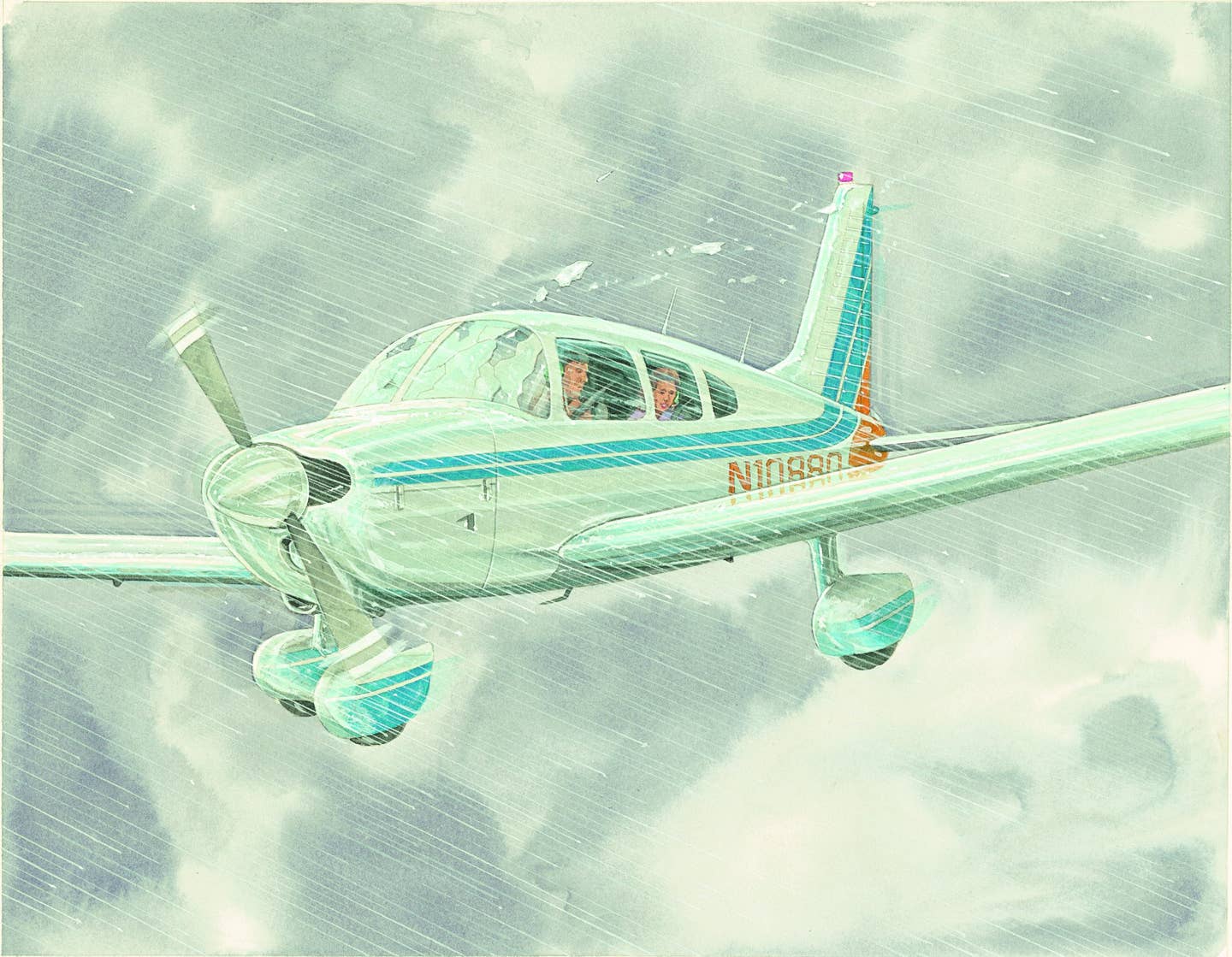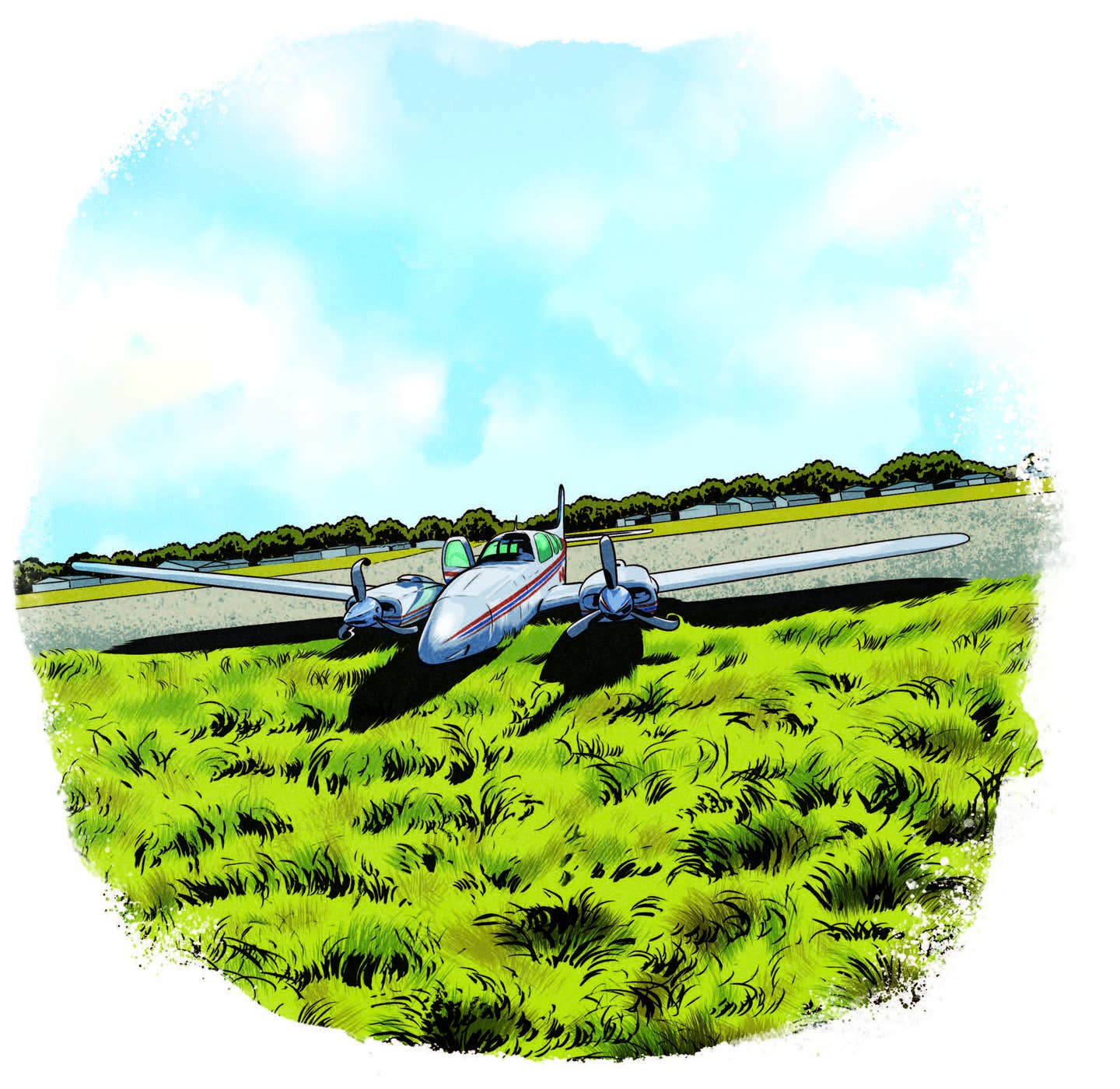
When your windshield and wings are covered in ice and the weather’s only getting worse, each decision is more important than the last. Barry Ross/BarryRossArt.com
I was a 30-year-old 600-hour instrument instructor with half ownership in a well-equipped Piper Archer II and a good job to pay the bills. I felt I had a good understanding of my personal minimums and promised myself never to break them — a policy that has paid off many times. But that almost wasn’t the case on one chilly October day in New York.
Ever since I’d started flying out of Westchester County Airport (HPN), my brother Gene, who has a passion for gems and minerals, had urged me to take him to Herkimer, New York, to search for crystals. That region of upstate New York has a reputation for growing some beautiful clear gem formations within the mountainsides — so clear that they are often called “Herkimer diamonds.” I invited my girlfriend and brother Ed to join us and planned a simple instrument flight between HPN and Utica Airport (UCA), north of the Catskill Mountains and only a few miles from Herkimer. On the morning of the trip, I called Flight Service to learn the forecast was VFR with some late-day buildups in front of a weak cold front. Otherwise, it appeared to be a fine day for flying.
Although I’d warned him about our limited load, Gene showed up with various mining tools, including chisels, hammers, and pails weighing enough that I needed to defuel one tank to the 17-gallon tab. My passengers requested a scenic route, so I filed north along the Hudson River and received clearance as filed. On landing, we found a pleasant FBO with a guest car waiting. I wrote up a fuel order to fill the tanks to the tabs, anticipating extra treasure on the return flight. It was a beautiful sunny day, reaching about 50 degrees F while we cracked open rocks. We found more than a few Herkimer diamonds.
Midday, I noticed some buildups off in the distant west, so I called Flight Service for an update. They noted scattered cumulus clouds and expected occasional passing cumulonimbus clouds in front of the cold front, about 100 miles west and moving slowly. As the buildups became more visible, I decided to play it safe and announced an earlier-than-planned departure. All were happy with the decision, but Gene started gathering as much unbroken rock as he could fit in his pail for cracking after he returned home. Knowing we had instructed the FBO to limit the fuel, I agreed to 40 pounds of rock, leaving ample margin to the airplane’s weight limits.
When we returned to the field, we stopped at the on-field FSS. The specialist assured me my route would be fine, with only an initial 4,000-foot base, widely scattered cumulonimbus clouds and a freezing level above 5,000 feet. I filed for 6,000, with the MEA initially 3,700 feet but rising to 5,500 feet over the mountains.
When we returned to the airplane, I saw the fuel was topped off. I ran to the line boy and asked what had happened. He said it was his first day and he thought the top was the tab. He explained that the FBO didn’t have defueling equipment, so I suggested they find some pails to capture the fuel. The FBO produced only one pail, so I emptied the rocks from one of our pails and started the draining process.
Fretting over the slow defueling, I decided it was time to share the bad news with Gene. Some of his rocks would need to stay back. He agreed without argument. We left the fuel buckets with the line boy and prepared for departure.
As expected, the Cherokee lifted off a little later than normal, but it performed well as I entered the clouds. As I leveled off at 6,000, I noticed the clouds getting darker. With the OAT at 32 degrees F, I started seeing rain immediately freezing to the windshield, resulting in each drop creating a frozen upside-down teardrop of ice. Within seconds the windshield was covered and the wings were building with rime. I told ATC that I was picking up ice and needed to change altitude. He offered a climb to 10,000 feet. Hearing a US Airways MD-80 at 11, I asked ATC for his conditions. He indicated moderate to severe ice. I immediately asked for lower as my airspeed indicator fell to zero. I turned on the pitot heat and the indicator came back alive.
I urged ATC to provide a descent to 5,000 feet but was rebuffed due to opposite-direction traffic. My airspeed was decreasing as my angle of attack was increasing to maintain altitude. When I reached Vy, I told ATC I must get lower and requested a diversion to the closest airport with an approach. He suggested the Oneonta, New York, airport (N66), 15 miles away. I told ATC I wanted the closest approach. With the airspeed now down to Vx, ATC gave me a vector and clearance to descend to 5,000 feet.
As we leveled off at 5,000, the ice on the windshield started to crack. We were still in the clouds, yet the freezing rain now turned to moderate rain, which helped dislodge sizable pieces of ice from the windshield — such a welcome sight. At the 4,400-foot MDA, we broke out of the bases into a scud layer in light rain with a few miles of visibility. In and out of the scud, I saw the beacon and entered a tight downwind, maintaining speed because the wing ice was substantial and none seemed to want to leave us.
I remembered the advice of maintaining excess speed when carrying ice, especially the amount I was looking at on the leading edges. I headed downhill at over 90 knots with the flaps up and, knowing we had a lengthy runway, maintained good speed all the way to the ground.
After landing and shutdown, I exited the airplane and walked on what felt like rubber legs. I grabbed the leading-edge ice with two full hands and pulled off what was about a half-inch layer that extended about 4 inches across the full span of the wings. As we walked into the FBO, the phone rang; it was ATC asking if we’d arrived OK. At that point, I started to process the reality of what had almost happened and how things could have turned out very differently.
We asked for the nearest hotel and made our way in rain that lasted until morning. That night I replayed the events over and over, trying to understand how I could have avoided letting things get that close to disaster.
The skies were clear the next morning, so we headed to the airport. The FBO dispatcher asked if we were the flight that had trouble getting in the day before. He said we were lucky we didn’t arrive 15 minutes later; the ceiling had come down and a commuter flight was not able to make it in. If I had needed to execute a missed approach, I doubt we would have had the ability to climb.
There are a few things I could have done differently, considering that the information I was given all seemed to be safe before launching into the air. Today I know more about temperature inversions and realize I could have done a better job of forecasting this extremely dangerous condition. I now remember to turn on pitot heat as soon as I enter freezing conditions. I also make sure I am totally clear when requesting fuel to a level below full tanks.
Something I did right: Ice accumulations reached a limit where we were starting to lose altitude. If I had allowed any more weight on board, the flight would have ended abruptly. I thank my instructors for instilling in me the good sense to never break limits.
I realized that I never declared an emergency; though my hands were full at the time, those few words simply didn’t come to mind. If I had declared an emergency, I might have been given the lower altitude a few seconds earlier, which might have resulted in a safer situation.
I was honestly embarrassed that this happened to me, and for a time, I would rarely share the story. But after many years and thousands of hours of flight instruction, I realized that this story needs to be told, and it might teach others about a situation in which what appeared to be a safe flight almost became my last one.
P.S.: I just celebrated my 25-year anniversary of marriage with the brave girlfriend who sat in one of the rear seats.
Robert M. Hanrahan has over 3,000 hours of flight time and holds an ATP and CFII/MEI certificates. On the weekends Bob can be found teaching at Century Air/KCDW.

Sign-up for newsletters & special offers!
Get the latest FLYING stories & special offers delivered directly to your inbox






